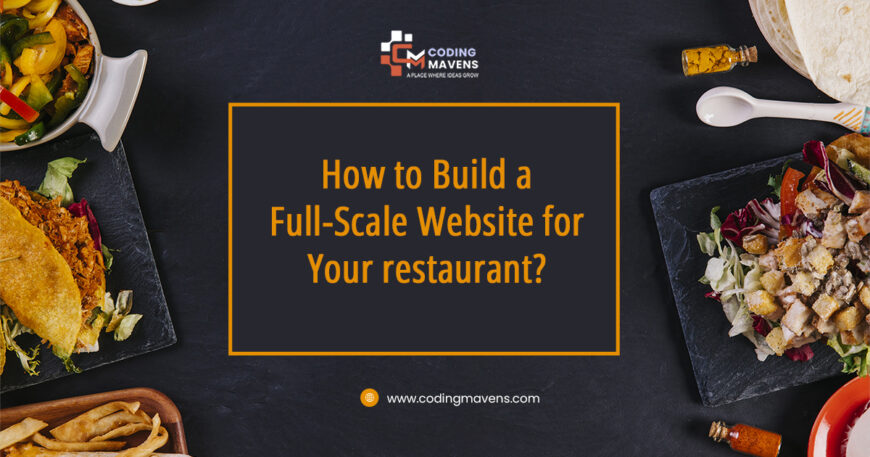It will take some time to get more customers to your restaurant, whether you just opened it or want to reopen in the near future. You are aware that potential customers are starving at home and looking for a great restaurant on Google. However, how can you reach them? utilizing your website.
How to make a website for a restaurant?
If you don’t have one already, you need one. Here are the most important things to think about when building your website to help bring in more customers.
1. Build your own website or hire a developer
Before you start building your website, there are some things you need to know. The most crucial factor is the amount of time and money you want to devote to the project. The most important thing is to figure out your ideal customers who will interact with you online in the same way that they did when your restaurant first opened. To figure out where a new website fits into your budget, look at your forecasts and financial statements. After that, figure out how much hands-on work you can handle. You can use this combination to determine whether you want to build your own website or hire a developer.
2. Choose a web domain
Regardless of your development path, you must select a web domain for your website. This is the URL for your website, which customers will likely see when they search for your restaurant and will likely be included on social media, business cards, and other materials. It ought to be brief, memorable, and evocative. In most cases, you should include a different name for your business. You run the risk of causing confusion for those looking for it if you make it too complicated or stray too far from it.
3. Draw out your pages
You must create your pages well even if you’re working with a designer. You need to know which pages you want. You probably don’t need specific product pages or categories because you aren’t an eCommerce platform or retailer. Simpler is usually better in restaurants, and you want to convince customers to eat your food right away before looking for something else.
4. Make it easy to find necessary information
When most people look at a restaurant’s website, they usually care about five things:
• Current Menu
• Hours of Operation
• Phone Number
• Specials / Happy Hour
• Address with a link to Google Maps
Your restaurant’s website should focus on answering your customers’ most pressing questions. They’ll start looking elsewhere if they can’t get the information they need in a few seconds.
5. Create an online menu
You absolutely need to have an online menu, which has already been mentioned a few times. However, there is a catch. It cannot simply be a printed copy of your menu.Therefore, when adding your menu, you should aim to replicate the best aspects of an in-person experience while making the process straightforward. Your website’s overall design may have an impact on how you actually put your digital menu into action. Take inspiration from other websites and select the option that best serves your customers and your brand.
6. Showcase your food
With high-quality photographs, you can convey a lot about your restaurant. It shows how it looks, how it feels, and, of course, the food. And in point of fact, even if you have the most compelling descriptions, reasonable prices, and convenient business hours, the food is going to be what gets them to enter. You want the images you display to entice the customer in addition to making any necessary information immediately accessible. Therefore, the homepage should feature your best shots prominently. You can then use a variety of images of the restaurant, its staff, and additional food throughout the remainder of the website.
7. Integrate reservations and online ordering
In light of recent events, now is a great time to implement online ordering and pickup. It not only makes ordering easier for you but also makes it super convenient for your customers. Digital orders can be directly integrated with your current POS system, so you won’t have to deal with a lot of phone calls. Your website will also get a better return on investment if customers are able to place orders online. You can encourage them to “order now” directly from the website as opposed to asking them to “come visit” or “call to order.”
8. Connect your social media accounts
![]()
Having a connected presence is one of the greatest advantages of being online. Your social media profiles, website, and Google listing all have the ability to display the same information in very different ways. However, they can also be interwoven to enhance the narrative of your brand. Include links to your social media profiles somewhere on your website if you have any. A great way to show off your brand is to feature posts from customers or your own feeds.
9. Encourage subscribers
One of the advantages of having a website is the capacity to collect customer data. You can get some of this information from web analytics, which can help you improve your website, but lead generation forms can also give you more in-depth information. The advantage for you is that you can now communicate directly with your clients.
10. Test and improve your SEO
A website is not created or redesigned in a single step. You will need to keep your website and business up to date and maintained in order for them to remain relevant. The simplest component of this is simply updating any restaurant information, menu items, or images. Maintaining the health of your website and optimizing it to attract more visitors is the more difficult part.
Conclusion
In conclusion, building a restaurant website need not be difficult or costly. It’s simple and affordable with all-in-one website builders. Therefore, simply construct your restaurant website and begin developing your online brand presence immediately.




